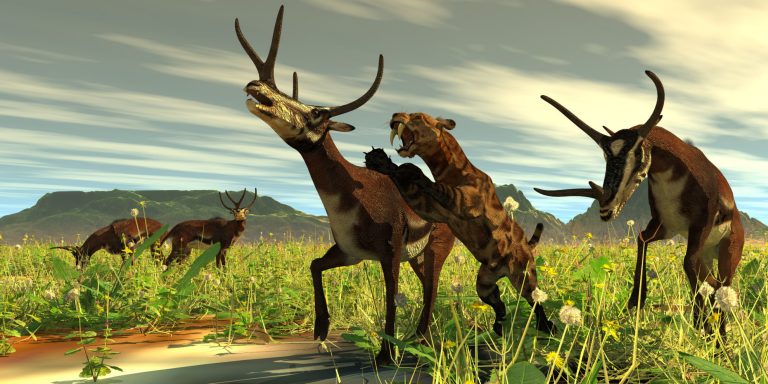Early Mammals on Earth

An illustration of “Kyptoceras” being attacked by Saber-toothed Cat during the Pleistocene Period
Table of Contents
By the time the dinosaurs were extinct 65 million years ago, the world’s landmass had split up into more or less the present-day continents as opposed to the Pangaea that was initially inhabited by the first dinosaurs.
Much of this geological change is the factor that molded the mammalian species of today’s planet.
Geological Change and Natural Selection
It is not entirely known what killed off the dinosaurs, but after this time, the Earth’s ecosphere was rapidly changing and throwing up a wide range of ecological niches that new adaptive organisms could fit into. This would further accelerate evolution and adaptation by all animals, including mammals.
The most noted difference, as above, was that mammalian species developed in different continents, and although possessed many similar characteristics, they had adapted to suit their own unique environment. Each continent, therefore, had its own variety of mammalian organisms and their own unique evolutionary chain and direction.
The Miocene Epoch
This epoch is of importance to mammals because it was the time that super-continent Eurasia (Europe and Asia) collided with Africa, allowing the previously speciated mammals of both continents to diverse into each other’s ecological niches, and to an extent, allow offspring to be produced between Eurasian and African species that were sufficiently similar enough still in ancestral terms to still breed with one another.
What was previously a geographical barrier (the ocean) was now a bridge between two continents, which greatly accelerated genetic diversity and competition between species and predator/prey relationships. This survival of the fittest in accordance with Charles Darwin’s theory of evolution would greatly help in diversifying species to what would become the species of present-day Earth.
More Geological Change
While competition from other organisms (reptiles/fish/birds) was minimal, evolution made its mark on mammal organisms as they continued to evolve and adapt to the ecological niches land offered. In fact, mammals were so good at adapting, that they also began to occupy the air and water in tandem with their main ecological niche, land.
Land provided an area for evolution to continue, where man’s distant relatives would have lived and taken advantage of their wild habitats millions upon millions of years ago.
The mammals diversified to the point of speciation, each inhabiting its own ecological niche and exhibiting its own selective advantages.
You will also like...

Animal Water Regulation
Animals adapt to their environment in aspects of anatomy, physiology, and behavior. This tutorial will help you understa..

Plant Water Regulation
Plants need to regulate water in order to stay upright and structurally stable. Find out the different evolutionary adap..

The Water Cycle
The water cycle (also referred to as the hydrological cycle) is a system of continuous transfer of water from the air, s..

Adaptation Tutorial
Adaptation, in biology and ecology, refers to the process or trait through which organisms or the populations in a habit..

Plant Biology
Plantlife can be studied at a variety of levels, from the molecular, genetic and biochemical level through organelles, c..

The Origins of Life
This tutorial digs into the past to investigate the origins of life. The section is split into geological periods in the..
